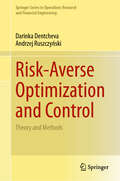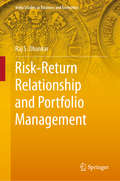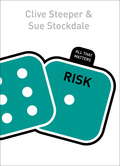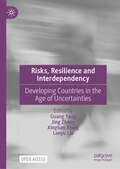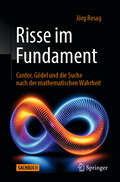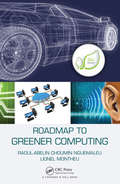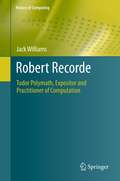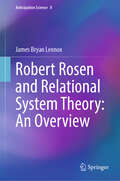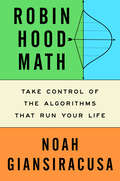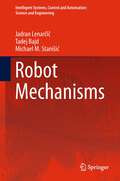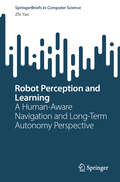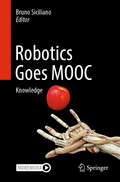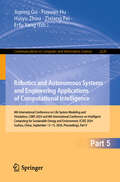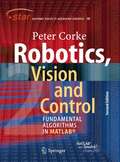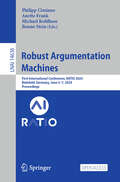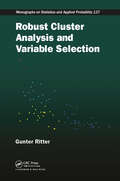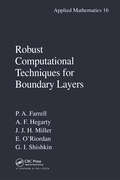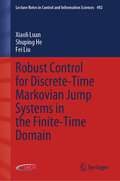- Table View
- List View
Risk-Averse Optimization and Control: Theory and Methods (Springer Series in Operations Research and Financial Engineering)
by Darinka Dentcheva Andrzej RuszczyńskiThis book offers a comprehensive presentation of the theory and methods of risk-averse optimization and control. Problems of this type arise in finance, energy production and distribution, supply chain management, medicine, and many other areas, where not only the average performance of a stochastic system is essential, but also high-impact and low-probability events must be taken into account. The book is a self-contained presentation of the utility theory, the theory of measures of risk, including systemic and dynamic measures of risk, and their use in optimization and control models. It also covers stochastic dominance relations and their application as constraints in optimization models. Optimality conditions for problems with nondifferentiable and nonconvex functions and operators involving risk measures and stochastic dominance relations are discussed. Much attention is paid to multi-stage risk-averse optimization problems and to risk-averse Markov decision problems. Specialized algorithms for solving risk-averse optimization and control problems are presented and analyzed: stochastic subgradient methods for risk optimization, decomposition methods for dynamic problems, event cut and dual methods for stochastic dominance constraints, and policy iteration methods for control problems. The target audience is researchers and graduate students in the areas of mathematics, business analytics, insurance and finance, engineering, and computer science. The theoretical considerations are illustrated with examples, which make the book useful material for advanced courses in the area.
Risk-Return Relationship and Portfolio Management (India Studies in Business and Economics)
by Raj S. DhankarThis book covers all aspects of modern finance relating to portfolio theory and risk–return relationship, offering a comprehensive guide to the importance, measurement and application of the risk–return hypothesis in portfolio management. It is divided into five parts: Part I discusses the valuation of capital assets and presents various techniques and models used in this context. Part II then addresses market efficiency and capital market models, particularly focusing on measuring market efficiency, which is a crucial factor in making correct investment decisions. It also analyzes the major capital market models like CAPM and APT to determine to what extent they are suitable for use in developing economies. Part III highlights the significance of risk–return analysis as a prerequisite for investment decisions, while Part IV examines the selection and performance appraisals of portfolios against the backdrop of the risk–return relationship. It also examines new tools such as the value-at-risk application for mutual funds and the applications of the price-to-earnings ratio in portfolio performance measurement. Lastly, Part V explores contemporary issues in finance, including the relevance of Islamic finance in the increasingly volatile global financial system.
Risk: All That Matters
by Clive Steeper Sue StockdaleWe are all risk takers. In life and in business, human attitudes towards risk are terrifyingly irrational. We hugely over-estimate short-term risks (standing near a cliff edge, or selling to someone who may not be credit worthy) but we under-estimate long-term risks (smoking, or acquiring a large company). This book seeks to understand risk from the human perspective. Why do we decide the things that we do, and how can we do it differently or better? This book should be required reading not just for students of business or economics, but for anyone faced with making important decisions.
Risk: All That Matters (All That Matters)
by Clive Steeper Sue StockdaleWe are all risk takers.In life and in business, human attitudes towards risk are terrifyingly irrational. We hugely over-estimate short-term risks (standing near a cliff edge, or selling to someone who may not be credit worthy) but we under-estimate long-term risks (smoking, or acquiring a large company).This book seeks to understand risk from the human perspective. Why do we decide the things that we do, and how can we do it differently or better? This book should be required reading not just for students of business or economics, but for anyone faced with making important decisions.
Risks, Resilience and Interdependency: Developing Countries in the Age of Uncertainties
by Jing Zhang Guang Yang Lanyu Liu Xinghan XiongThis open access book is a collection of selected papers from the 3rd Tsinghua Area Studies forum by the Institute for International and Area Studies (IIAS) at Tsinghua University in Beijing, theming at &“Developing Countries in the Age of Uncertainties: Risk, Resilience and Interdependency&”. From the perspective of area studies, the risks faced by more fragile developing countries in an environment of uncertainty and the resilience and interdependency exhibited in the face of risks were discussed. The discussion was a brave attempt by the IIAS to inject more certainty into the uncertain world. A total of 131 papers by scholars from various countries were presented in this forum. After the forum, the editorial group of the IIAS Forum Proceedings selected ten outstanding papers and compiled them under the title &“Risk, Resilience and Interdependency: Developing Countries in the Age of Uncertainty.&”
Risse im Fundament: Cantor, Gödel und die Suche nach der mathematischen Wahrheit
by Jörg ResagWoher wissen wir was wahr ist? Wofür brauchen wir mathematische Beweise? Was hat es mit Gödels berühmten Unvollständigkeitssätzen auf sich? In diesem Sachbuch tauchen wir ein in die Aussagekraft mathematischer Systeme und lernen ihre prinzipiellen Grenzen kennen. Nicht jede mathematische Aussage, die man formulieren kann, lässt sich aus den akzeptierten Axiomen auch beweisen oder widerlegen. Die Fundamente der Mathematik sind nicht so stabil und klar, wie es zunächst scheint.
Roadmap to Greener Computing
by Raoul-Abelin Choumin Nguemaleu Lionel MontheuAs computers become faster, use more energy, and older models become obsolete more quickly, the question is often asked: What can the engineering and computer science community do to make computing greener? Roadmap to Greener Computing defines the challenges involved in making computing more environmentally friendly and includes methods and techniq
Roads to Infinity: The Mathematics of Truth and Proof (AK Peters/CRC Recreational Mathematics Series)
by John StillwellWinner of a CHOICE Outstanding Academic Title Award for 2011!This book offers an introduction to modern ideas about infinity and their implications for mathematics. It unifies ideas from set theory and mathematical logic, and traces their effects on mainstream mathematical topics of today, such as number theory and combinatorics. The treatment is h
Robert Recorde: Tudor Polymath, Expositor and Practitioner of Computation
by Jack WilliamsThe 16th-Century intellectual Robert Recorde is chiefly remembered for introducing the equals sign into algebra, yet the greater significance and broader scope of his work is often overlooked. This book presents an authoritative and in-depth analysis of the man, his achievements and his historical importance. This scholarly yet accessible work examines the latest evidence on all aspects of Recorde's life, throwing new light on a character deserving of greater recognition. Topics and features: presents a concise chronology of Recorde's life; examines his published works; describes Recorde's professional activities in the minting of money and the mining of silver, as well as his dispute with William Herbert, Earl of Pembroke; investigates Recorde's work as a physician, his linguistic and antiquarian interests, and his religious beliefs; discusses the influence of Recorde's publisher, Reyner Wolfe, in his life; reviews his legacy to 17th-Century science, and to modern computer science and mathematics.
Robert Rosen and Relational System Theory: An Overview (Anticipation Science #8)
by James Bryan LennoxThis book focuses on Robert Rosen’s contributions to relational system theory, which is the science of organization and function. This science was originally developed by Nicolas Rashevsky, and further developed by Rashevsky’s student Robert Rosen, and continues to be developed by Rosen’s student A. H. Louie amongst others. Due to its revolutionary character, it is often misunderstood, and to some, controversial. The formal and conceptual setting for Rosen’s relational system theory is category theory. Rosen was the first to apply category theory to scientific problems, outside of pure mathematics, and the first to think about science from the point of view of category theory. To better understand the work of Rosen, this book provides an overview of his theory of modeling, complexity, anticipation, and organism. It presents the foundations of this science and the philosophical motivations behind it along with conceptual clarification and historical context in order to present Rosen’s ideas to a wider audience.
Robin Hood Math: Take Control of the Algorithms That Run Your Life
by Noah GiansiracusaHow the rich and powerful use math to exploit you, and what you can do to beat them at their own game Everything we do today is recorded as data that's sold to the highest bidder. Plugging our personal data into impersonal algorithms has made government agencies more efficient and tech companies more profitable. But all this comes at a price. It's easy to feel like an insignificant number in a world of number crunchers who care more about their bottom line than your humanity. It's time to flip the equation, turning math into an empowering tool for the rest of us. Award-winning mathematician Noah Giansiracusa explains how the tech giants and financial institutions use formulas to get ahead—and how anyone can use these same formulas in their everyday life. You&’ll learn how to handle risk rationally, make better investments, take control of your social media, and reclaim agency over the decisions you make each day. In a society that all too often takes from the poor and gives to the rich, math can be a vital democratizing force. Robin Hood Math helps you to think for yourself, act in your own best interests, and thrive.
Robot Mechanisms
by Tadej Bajd Jadran Lenarcic Michael M. StanišićThis book provides a comprehensive introduction to the area of robot mechanisms, primarily considering industrial manipulators and humanoid arms. The book is intended for both teaching and self-study. Emphasis is given to the fundamentals of kinematic analysis and the design of robot mechanisms. The coverage of topics is untypical. The focus is on robot kinematics. The book creates a balance between theoretical and practical aspects in the development and application of robot mechanisms, and includes the latest achievements and trends in robot science and technology.
Robot Perception and Learning: A Human-Aware Navigation and Long-Term Autonomy Perspective (SpringerBriefs in Computer Science)
by Zhi YanThis book is divided into five chapters. Chapter 1 introduces the background of the research, the content positioning, and some related open source resources. Chapter 2 discusses some benchmarking issues related to the field of embodied intelligence and mobile robotics. Chapter 3 introduces robot perception, especially the object detection and tracking based on 3D lidar with contemporary characteristics. Chapter 4 introduces robot learning, especially robot online learning methods with strong embodied intelligence features. Chapter 5 summarizes the book and provides prospects for future research and application directions.Reading this book helps readers have a systematic understanding of the latest research in related fields. The book mainly introduces methods and principles, and the corresponding experimental results need to refer to the corresponding scientific papers. This book is aimed at practitioners in the field with a certain knowledge base, including but not limited to graduate students, Ph.D. students, postdocs, etc.
Robotic Musicianship: Embodied Artificial Creativity and Mechatronic Musical Expression (Automation, Collaboration, & E-Services #8)
by Scott Driscoll Gil Weinberg Mason Bretan Guy HoffmanThis book discusses the principles, methodologies, and challenges of robotic musicianship through an in-depth review of the work conducted at the Georgia Tech Center for Music Technology (GTCMT), where the concept was first developed. Robotic musicianship is a relatively new research field that focuses on the design and development of intelligent music-making machines. The motivation behind the field is to develop robots that not only generate music, but also collaborate with humans by listening and responding in an expressive and creative manner. This combination of human and machine creativity has the potential to surprise and inspire us to play, listen, compose, and think about music in new ways. The book provides an in-depth view of the robotic platforms designed at the GTCMT Robotic Musicianship Group, including the improvisational robotic percussionists Haile and Shimon, the personal robotic companion Shimi, and a number of wearable robots, such as the Robotic Drumming Prosthesis, The Third Drumming Arm, and the Skywalker Piano Hand. The book discusses numerous research studies based on these platforms in the context of five main principles: Listen like a Human, Play Like a Machine, Be Social, Watch and Learn, and Wear It.
Robotics Goes MOOC: Knowledge
by Bruno SicilianoThe robot “concept” was clearly established by those many creative historical realizations, such as those recalled above. Nonetheless, the emergence of the “physical” robot had to await the advent of its underlying technologies of mechanics, controls, computers, electronics and sensors ―in one word, mechatronics― during the course of the twentieth century. As always, new designs motivate new research and discoveries which, in turn, lead to enhanced solutions and thus to novel concepts. This virtuous circle over time produced that knowledge and understanding which gave birth to the field of Robotics, properly referred to as the science and technology of robots.To make robots and intelligent machines useful to humans it is necessary to have a broad and tight intersection between Robotics and AI. Sophisticated mathematical models are needed that enable the robot from a physical point of view, as well as intelligent algorithms capable of correlating all the information coming from the use of technologically advanced sensors with the data available from experience. It is expected that the synergy of model-based techniques with data-driven approaches will contribute to increasing the level of autonomy of robots and intelligent machines in the near future.The first book of the Robotics Goes MOOC project starts with the journey of robotics in the introductory chapter by Khatib, who has pioneered our field of robotics and has ferried it to the third millennium. Sensing is crucial for the development of intelligent and autonomous robots, as covered in Chapter 2 by Nüchter et al. Model-based control is dealt with in Chapter 3 by Kröeger et al along with motion planning, as well as in Chapter 4 by Villani and Chapter 5 by Chaumette to handle force and visual feedback, respectively, when interacting with the environment. Resorting to AI techniques is the focus of the last part of the book, namely, Chapter 6 by Peters et al on Learning, Chapter 7 byBeetz et al on knowledge representation and reasoning, and Chapter 8 by Burgard et al on graph-based SLAM.
Robotics and Autonomous Systems and Engineering Applications of Computational Intelligence: 8th International Conference on Life System Modeling and Simulation, LSMS 2024, and 8th International Conference on Intelligent Computing for Sustainable Energy and Environment, ICSEE 2024, Suzhou, China, September 13–15, 2024, Proceedings, Part V (Communications in Computer and Information Science #2220)
by Fuyuan Hu Huiyu Zhou Juping Gu Zixiang Fei Erfu YangThe five-volume set constitutes the thoroughly refereed proceedings of the 8th International Conference on Life System Modeling and Simulation, LSMS 2024, and of the 8th International Conference on Intelligent Computing for Sustainable Energy and Environment, ICSEE 2024, which were held during September 13-15, in Suzhou, China. The 31 papers presented were carefully reviewed and selected from over 496 submissions. The LSMS and ICSEE international conference series aim to bring together international researchers and practitioners in the fields of advanced methods for life system modeling and simulation, as well as advanced intelligent computing theory, methodologies, and engineering applications in achieving net zero across all sectors to tackle the global climate change challenge.
Robotics, Vision And Control: Fundamental Algorithms In Matlab - 2nd, Completely Revised, Extended And Updated Edition (Springer Tracts In Advanced Robotics #118)
by Peter CorkeRobotic vision, the combination of robotics and computer vision, involves the application of computer algorithms to data acquired from sensors. The research community has developed a large body of such algorithms but for a newcomer to the field this can be quite daunting. For over 20 years the author has maintained two open-source MATLAB® Toolboxes, one for robotics and one for vision. They provide implementations of many important algorithms and allow users to work with real problems, not just trivial examples. <P><P>This book makes the fundamental algorithms of robotics, vision and control accessible to all. It weaves together theory, algorithms and examples in a narrative that covers robotics and computer vision separately and together. Using the latest versions of the Toolboxes the author shows how complex problems can be decomposed and solved using just a few simple lines of code. The topics covered are guided by real problems observed by the author over many years as a practitioner of both robotics and computer vision. It is written in an accessible but informative style, easy to read and absorb, and includes over 1000 MATLAB and Simulink® examples and over 400 figures. The book is a real walk through the fundamentals of mobile robots, arm robots. then camera models, image processing, feature extraction and multi-view geometry and finally bringing it all together with an extensive discussion of visual servo systems. This second edition is completely revised, updated and extended with coverage of Lie groups, matrix exponentials and twists; inertial navigation; differential drive robots; lattice planners; pose-graph SLAM and map making; restructured material on arm-robot kinematics and dynamics; series-elastic actuators and operational-space control; Lab color spaces; light field cameras; structured light, bundle adjustment and visual odometry; and photometric visual servoing. “An authoritative book, reaching across fields, thoughtfully conceived and brilliantly accomplished!”
Robots Unlimited: Life in a Virtual Age
by David LevyConsider this: Robots will one day be able to write poetry and prose so touching that it will make men weep; compose dozens or even hundreds of symphonies that will rival the work of Mozart; judge a court case with absolute impartiality and fairness; or even converse with the natural ease of your best friend. Robots will one day be so life-like tha
Robust Argumentation Machines: First International Conference, RATIO 2024, Bielefeld, Germany, June 5–7, 2024, Proceedings (Lecture Notes in Computer Science #14638)
by Michael Kohlhase Philipp Cimiano Benno Stein Anette FrankThis open access book constitutes the proceedings of the First International Conference on Robust Argumentation Machines, RATIO 2024, which took place in Bielefeld, Germany, during June 5-7, 2024. The 20 full papers and 1 short paper included in the proceedings were carefully reviewed and selected from 24 submissions. They were organized in topical sections as follows: Argument Mining; Debate Analysis and Deliberation; Argument Acquisition, Annotation and Quality Assessment; Computational Models of Argumentation; Interactive Argumentation, Recommendation and Personalization; and Argument Search and Retrieval.
Robust Cluster Analysis and Variable Selection (ISSN)
by Gunter RitterClustering remains a vibrant area of research in statistics. Although there are many books on this topic, there are relatively few that are well founded in the theoretical aspects. In Robust Cluster Analysis and Variable Selection, Gunter Ritter presents an overview of the theory and applications of probabilistic clustering and variable selection,
Robust Computational Techniques for Boundary Layers
by Grigory I. Shishkin Paul Farrell Alan Hegarty John M. Miller Eugene O'RiordanCurrent standard numerical methods are of little use in solving mathematical problems involving boundary layers. In Robust Computational Techniques for Boundary Layers, the authors construct numerical methods for solving problems involving differential equations that have non-smooth solutions with singularities related to boundary layers. They pres
Robust Control Design for Active Driver Assistance Systems
by Péter Gáspár Zoltán Szabó József Bokor Balazs NemethThis monograph focuses on control methods that influence vehicle dynamics to assist the driver in enhancing passenger comfort, road holding, efficiency and safety of transport, etc. , while maintaining the driver's ability to override that assistance. On individual-vehicle-component level the control problem is formulated and solved by a unified modelling and design method provided by the linear parameter varying (LPV) framework. The global behaviour desired is achieved by a judicious interplay between the individual components, guaranteed by an integrated control mechanism. The integrated control problem is also formalized and solved in the LPV framework. Most important among the ideas expounded in the book are: application of the LPV paradigm in the modelling and control design methodology; application of the robust LPV design as a unified framework for setting control tasks related to active driver assistance; formulation and solution proposals for the integrated vehicle control problem; proposal for a reconfigurable and fault-tolerant control architecture; formulation and solution proposals for the plug-and-play concept; detailed case studies. Robust Control Design for Active Vehicle Assistance Systems will be of interest to academic researchers and graduate students interested in automotive control and to control and mechanical engineers working in the automotive industry. Advances in Industrial Control aims to report and encourage the transfer of technology in control engineering. The rapid development of control technology has an impact on all areas of the control discipline. The series offers an opportunity for researchers to present an extended exposition of new work in all aspects of industrial control.
Robust Control for Discrete-Time Markovian Jump Systems in the Finite-Time Domain (Lecture Notes in Control and Information Sciences #492)
by Fei Liu Shuping He Xiaoli LuanThis book provides robust analysis and synthesis tools for Markovian jump systems in the finite-time domain with specified performances. It explores how these tools can make the systems more applicable to fields such as economic systems, ecological systems and solar thermal central receivers, by limiting system trajectories in the desired bound in a given time interval.Robust Control for Discrete-Time Markovian Jump Systems in the Finite-Time Domain focuses on multiple aspects of finite-time stability and control, including: finite-time H-infinity control;finite-time sliding mode control;finite-time multi-frequency control;finite-time model predictive control; andhigh-order moment finite-time control for multi-mode systems and also provides many methods and algorithms to solve problems related to Markovian jump systems with simulation examples that illustrate the design procedure and confirm the results of the methods proposed.The thorough discussion of these topics makes the book a useful guide for researchers, industrial engineers and graduate students alike, enabling them systematically to establish the modeling, analysis and synthesis for Markovian jump systems in the finite-time domain.
Robust Control of Jump Linear Stochastic Systems: Applications to Sampled-Data Control (Lecture Notes in Control and Information Sciences #497)
by Vasile Drăgan Samir Aberkane Ioan Lucian PopaThis monograph concentrates on the theory of robust control of linear impulsive stochastic systems and stochastic systems with jumps. It discusses theoretical points concerned with impulsive stochastic systems including optimal control, robust stabilization, and H2- and Hinfinity-type results. Considering the major role played by the impulsive Lyapunov and impulsive Riccati equations in these problems, the book presents a thorough treatment of these equations in a general framework. It also presents various applications to sampled-data control. Robust Control of Jump Linear Stochastic Systems is a self-contained and clearly structured presentation of up-to-date research in this area, relevant to researchers in control theory and to non-specialists who are interested in the theory of robust control of linear impulsive stochastic systems. Theoretical and applied mathematicians, research engineers, and graduate students in the aforementioned fields will also find value in this book.
Robust Control of Linear Descriptor Systems
by Yu Feng Mohamed YagoubiThis book develops original results regarding singular dynamic systems following two different paths. The first consists of generalizing results from classical state-space cases to linear descriptor systems, such as dilated linear matrix inequality (LMI) characterizations for descriptor systems and performance control under regulation constraints. The second is a new path, which considers descriptor systems as a powerful tool for conceiving new control laws, understanding and deciphering some controller's architecture and even homogenizing different--existing--ways of obtaining some new and/or known results for state-space systems. The book also highlights the comprehensive control problem for descriptor systems as an example of using the descriptor framework in order to transform a non-standard control problem into a classic stabilization control problem. In another section, an accurate solution is derived for the sensitivity constrained linear optimal control also using the descriptor framework. The book is intended for graduate and postgraduate students, as well as researchers in the field of systems and control theory.
